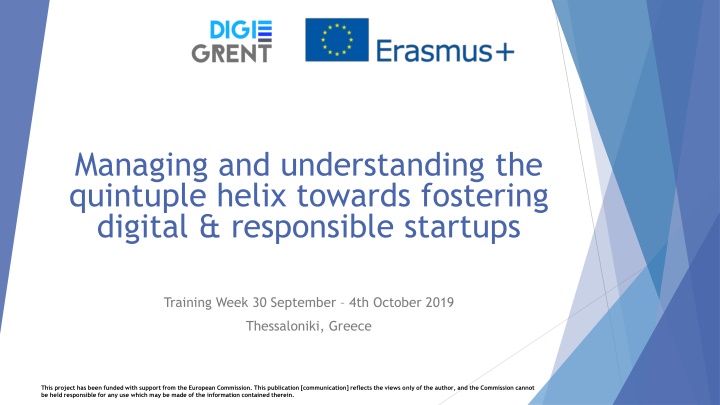
Quintuple Helix Framework for Digital and Responsible Startups
Explore the evolution from Triple Helix to Quintuple Helix model, incorporating civil society and the environment. Learn about the interactions between academia, industry, governments, civil society, and the environment to foster innovation and economic development in the context of digital and responsible startups.
Download Presentation

Please find below an Image/Link to download the presentation.
The content on the website is provided AS IS for your information and personal use only. It may not be sold, licensed, or shared on other websites without obtaining consent from the author. If you encounter any issues during the download, it is possible that the publisher has removed the file from their server.
You are allowed to download the files provided on this website for personal or commercial use, subject to the condition that they are used lawfully. All files are the property of their respective owners.
The content on the website is provided AS IS for your information and personal use only. It may not be sold, licensed, or shared on other websites without obtaining consent from the author.
E N D
Presentation Transcript
Managing and understanding the quintuple helix towards fostering digital & responsible startups Training Week 30 September 4th October 2019 Thessaloniki, Greece This project has been funded with support from the European Commission. This publication [communication] reflects the views only of the author, and the Commission cannot be held responsible for any use which may be made of the information contained therein.
Contents 1. Quintuple Helix Eco-friendly (EF) / Responsible (R) and Digital (D) Business Models / Start-ups 4. ICT 2. Networking Management 3. Corporate Social Responsibility This project has been funded with support from the European Commission. This publication [communication] reflects the views only of the author, and the Commission cannot be held responsible for any use which may be made of the information contained therein.
Triple Helix the origin of Quintuple Helix The triple helix model of innovation refers to a set of interactions between academia, industry and governments, to foster economic and social development This framework was first theorized by Henry Etzkowitz and Loet Leydesdorff in the 1990s The triple helix model of Innovation is based on the interactions between the three following elements and their associated initial role : universities providing education to individuals and engaging in basic research industries producing commercial goods governments that are regulating markets 1. "The Triple Helix Concept". Stanford University Triple Helix Research Group. 11 July 2011. 2. Leydesdorff, Loet (2012). "The Knowledge-Based Economy and the Triple Helix Model" . University of Amsterdam, Amsterdam School of Communications Research. 3. Leydesdorff, Loet; Lawton Smith, Helen. "The Triple Helix in the context of global change: dynamics and challenges" This project has been funded with support from the European Commission. This publication [communication] reflects the views only of the author, and the Commission cannot be held responsible for any use which may be made of the information contained therein.
Quadruple and Quintuple Innovation Helix The quadruple along with the quintuple innovation helix framework was co-developed by Elias G. Carayannis and David F.J. Campbell They extended and expanded substantially the triple helix model of Innovation, as the framework introduces civil society and the environment as pillars and focal points of policy and practice This project has been funded with support from the European Commission. This publication [communication] reflects the views only of the author, and the Commission cannot be held responsible for any use which may be made of the information contained therein.
The five helices Apart from active human agents, the most important constituent element of the quintuple helix is knowledge, which, through a circulation between societal subsystems, changes to innovation and know-how in a society and for the economy. The quintuple helix visualizes the collective interaction and exchange of this knowledge in a state by means of the following five subsystems (i.e., helices): education system economic system natural environment media-based and culture-based public (also civil society ) and the political system. 1. Barth, Thorsten D. (2011). "The Idea of a Green New Deal in a Quintuple Helix Model of Knowledge, Know-How and Innovation". International Journal of Social Ecology and Sustainable Development. 2 (1): 6 2. Carayannis, Elias G.; Campbell, David F.J. (2010). "Triple Helix, Quadruple Helix and Quintuple Helix and How Do Knowledge, Innovation and the Environment Relate To Each Other?: A Proposed Framework for a Trans-disciplinary Analysis of Sustainable Development and Social Ecology". International Journal of Social Ecology and Sustainable Development. 1 (1): 46 48, 62. This project has been funded with support from the European Commission. This publication [communication] reflects the views only of the author, and the Commission cannot be held responsible for any use which may be made of the information contained therein.
The five helices - continued Each of the five helices has an asset at its disposal, with a societal and scientific relevance. The education system defines itself in reference to academia, universities, higher education systems, and schools. In this helix, the necessary human capital (e.g., students, teachers, scientists/ researchers, academic entrepreneurs, etc.) of a state is being formed by diffusion and research of knowledge. The economic system consists of industry/industries, firms, services and banks. This helix concentrates and focuses the economic capital (e.g., entrepreneurship, machines, products, technology, money, etc.) of a state. The natural environment subsystem is decisive for sustainable development and provides people with natural capital (e.g., resources, plants, variety of animals, etc.). The media-based and culture-based public subsystem integrates and combines two forms of capital. This helix has, through the culture-based public (e.g., traditions, values, etc.), a social capital. In addition, the helix of media-based public (e.g., television, internet, newspapers, etc.) contains capital of information (e.g., news, communication, social networks). The political system formulates the will, i.e., where the state is heading, thereby also defining, organizing, and administering the general conditions of the state. Therefore, this helix has political and legal capital (e.g., ideas, laws, plans, politicians, etc.). This project has been funded with support from the European Commission. This publication [communication] reflects the views only of the author, and the Commission cannot be held responsible for any use which may be made of the information contained therein.
Circulation of knowledge 1. Carayannis, Elias G.; Barth, Thorsten D.; Campbell, David F.J. (2012). "The Quintuple Helix innovation model: global warming as a challenge and driver for innovation". Journal of Innovation and Entrepreneurship. 1 (2): 2. This project has been funded with support from the European Commission. This publication [communication] reflects the views only of the author, and the Commission cannot be held responsible for any use which may be made of the information contained therein.
Circulation of knowledge Step 1: When investments flow into the education helix to promote sustainable development, they create new impulses and suggestions for knowledge creation in the education system. Therefore, a larger output of innovations from science and research can be obtained. Simultaneously, teaching and training improve their effectiveness. The output that arises from human capital for sustainable development is then an input into the economic system helix. Step 2: Through the input of new knowledge via human capital into the economic system helix, the value of the knowledge economy consequently increases. Through the enhancement of knowledge, important further production facilitates and develops opportunities for a sustainable, future-sensitive green economy, based on knowledge creation. This knowledge creation realizes in the economic system new types of jobs, new green products and new green services, together with new and decisive impulses for greener economic growth. In this subsystem, new values, like corporate social responsibility, are demanded, enabling and supporting a new output of know-how and innovations by the economic system into the natural environment helix. Step 3: This new sustainability as an output of the economic system is a new input of knowledge in the natural environment helix. This new knowledge communicates to nature and results in less exploitation, destruction, contamination, and wastefulness. The natural environment can, thus, regenerate itself and strengthen its natural capital, and humanity can also learn from nature via new knowledge creation. The goal of this helix is to live in balance with nature, to develop regenerative technologies, and to use available, finite resources sustainably. Here, natural science disciplines come into play, forming new green know-how. This know-how is then an output of the natural environment subsystem into the public helix. This project has been funded with support from the European Commission. This publication [communication] reflects the views only of the author, and the Commission cannot be held responsible for any use which may be made of the information contained therein.
Circulation of knowledge Step 3: This new sustainability as an output of the economic system is a new input of knowledge in the natural environment helix. This new knowledge communicates to nature and results in less exploitation, destruction, contamination, and wastefulness. The natural environment can, thus, regenerate itself and strengthen its natural capital, and humanity can also learn from nature via new knowledge creation. The goal of this helix is to live in balance with nature, to develop regenerative technologies, and to use available, finite resources sustainably. Here, natural science disciplines come into play, forming new green know-how. This know-how is then an output of the natural environment subsystem into the public helix. Step 4: The output of the natural environment results in an input of new knowledge about nature and a greener lifestyle for the media-based and culture-based public helix. Here, the media-based public receives information capital, which spreads through the media information about a new green consciousness. This capital should provide incentives on how a green lifestyle can be implemented in a simple, affordable, and conscious way, i.e., knowledge creation. This knowledge creation promotes the social capital of the culture- based public, on which a society depends for sustainable development. This know-how output then serves as new input, about the wishes, needs, problems, or satisfaction of citizens, for the political system helix. Step 5: The input of knowledge into the political system is the know-how from the media-based and culture- based public together with the collective knowledge from the three other subsystems of society. Important discussions on this new knowledge in the political systems are necessary impulses for knowledge creation. The goal of this knowledge creation is political and legal capital, making the quintuple helix model more effective and more sustainable. Consequently, there is an output of suggestions, sustainable investments, and objectives. This leads to the circulation of knowledge back into the education system. This project has been funded with support from the European Commission. This publication [communication] reflects the views only of the author, and the Commission cannot be held responsible for any use which may be made of the information contained therein.
Quintuple Helix vs Eco-friendly/Responsible and Digital Business Models EF Which elements of the Quintuple Helix influence Eco-friendly Business Models / Start-ups ? In what way? D Which elements of the Quintuple Helix influence Digital (D) Business Models / Start-ups ? In what way? (EF)/ Responsible (R) This project has been funded with support from the European Commission. This publication [communication] reflects the views only of the author, and the Commission cannot be held responsible for any use which may be made of the information contained therein.
Quintuple Helix examples and further reading Carayannis, Elias G.; Barth, Thorsten D.; Campbell, David F.J. (2012). "The Quintuple Helix innovation model: global warming as a challenge and driver for innovation". Journal of Innovation and Entrepreneurship. 1 (2): 2 https://innovation-entrepreneurship.springeropen.com/track/pdf/10.1186/2192- 5372-1-2 Social Seeds, Interreg Europe. Methodology and Good practices on quintuple helix cooperations: Making better use of social entrepreneurship collaborations in policy improvements https://www.interregeurope.eu/fileadmin/user_upload/tx_tevprojects/library/file _1536063863.pdf This project has been funded with support from the European Commission. This publication [communication] reflects the views only of the author, and the Commission cannot be held responsible for any use which may be made of the information contained therein.
Corporate Social Responsibility (CSR) - definition Corporate social responsibility (CSR) is a type of international private business self-regulation that aims to contribute to societal goals of a philanthropic, activist, or charitable nature or by engage in or support volunteering or ethically-oriented practices. 1. Sheehy, Benedict "Defining CSR: Problems and Solutions". Journal of Business Ethics. 131 (3): 625 648. 2. Lee, Nancy; Kotler, Philip (2013). Corporate social responsibility doing the most good for your company and your cause. Hoboken, NJ: Wiley. 3.Carroll, Archie B. (July 1991). "The pyramid of corporate social responsibility: Toward the moral management of organizational stakeholders". Business Horizons. 34 (4): 39 48. This project has been funded with support from the European Commission. This publication [communication] reflects the views only of the author, and the Commission cannot be held responsible for any use which may be made of the information contained therein.
Corporate Social Responsibility (CSR) - definition Since the 1960s, corporate social responsibility has attracted attention from a range of businesses and stakeholders. A wide variety of definitions have been developed but with little consensus. Part of the problem with definitions has arisen because of the different interests represented: A business person may define CSR as a business strategy an NGO activist may see it as 'greenwash while a government official may see it as voluntary regulation. 1. Sheehy, Benedict "Defining CSR: Problems and Solutions". Journal of Business Ethics. 131 (3): 625 648. 2. Lee, Nancy; Kotler, Philip (2013). Corporate social responsibility doing the most good for your company and your cause. Hoboken, NJ: Wiley. 3.Carroll, Archie B. (July 1991). "The pyramid of corporate social responsibility: Toward the moral management of organizational stakeholders". Business Horizons. 34 (4): 39 48. This project has been funded with support from the European Commission. This publication [communication] reflects the views only of the author, and the Commission cannot be held responsible for any use which may be made of the information contained therein.
CSR approaches 1.Saether, Kim T.; Aguilera, Ruth V. (2008). "Corporate Social Responsibility in a Comparative Perspective". In Crane, A.; et al. (eds.). The Oxford Handbook of Corporate Social Responsibility. Oxford University Press. ISBN 978-0-19-921159-3. Archived from the original 2. Maverlinn and Vermander, B. (2013). "Corporate Social Responsibility in China: A Vision, an Assessment and a Blueprint, World Scientific". 3. Knox, Simon (2007). Ramsden, J.J.; Aida, S. and; Kakabadse, A (eds.). Corporate Social Responsibility and Business Decision Making. Spiritual Motivation: New Thinking for Business and Management. Basingstoke: Palgrave Macmillan. 4.Tilcsik, Andr s; Marquis, Christopher (1 February 2013). "Punctuated Generosity: How Mega-events and Natural Disasters Affect Corporate Philanthropy in U.S. Communities". Administrative Science Quarterly. 58 (1): 111 148. This project has been funded with support from the European Commission. This publication [communication] reflects the views only of the author, and the Commission cannot be held responsible for any use which may be made of the information contained therein.
Corporate social initiatives Corporate social responsibility includes six types of corporate social initiatives: Corporate philanthropy: company donations to charity, including cash, goods, and services, sometimes via a corporate foundation Community volunteering: company-organized volunteer activities, sometimes while an employee receives pay for pro-bono work on behalf of a non-profit organization Socially-responsible business practices: ethically produced products which appeal to a customer segment Cause promotions and activism: company-funded advocacy campaigns Cause-related marketing: donations to charity based on product sales Corporate social marketing: company-funded behavior-change campaigns This project has been funded with support from the European Commission. This publication [communication] reflects the views only of the author, and the Commission cannot be held responsible for any use which may be made of the information contained therein.
Common CSR actions Common CSR actions include: Environmental sustainability: recycling, waste management, water management, renewable energy, reusable materials, 'greener' supply chains, reducing paper use. Community involvement: This can include raising money for local charities, providing volunteers, sponsoring local events, employing local workers, supporting local economic growth, engaging in fair trade practices, etc. Ethical marketing: Companies that ethically market to consumers are placing a higher value on their customers and respecting them as people who are ends in themselves. They do not try to manipulate or falsely advertise to potential consumers. This is important for companies that want to be viewed as ethical. 1.Jones, Tegan (2007-05-14). "Talent Management". The Business Value of Virtue: Corporate Social Responsibility and Employee Engagement. 2. Matthews, Richard (2012-01-26). "The Green Market Oracle". Top Business Sustainability Trends for 2012. 3. "Great Forest". Services. 2013. 4. "Environmental Leader". Top Sustainability Consultants Revealed. 5. "Camden Community Empowerment Network". Camden Community Empowerment Network Jargon Buster. 6."Workforce Management". Starbucks is Pleasing Employees and Pouring Profits. October 2003. pp. 58 59. This project has been funded with support from the European Commission. This publication [communication] reflects the views only of the author, and the Commission cannot be held responsible for any use which may be made of the information contained therein.
Common CSR actions EF How CSR actions can be embedded into Eco- friendly (EF) / Responsible (R) Business Models / Start-ups? D How CSR actions can be embedded into Digital (D) Business Models / Start-ups ? This project has been funded with support from the European Commission. This publication [communication] reflects the views only of the author, and the Commission cannot be held responsible for any use which may be made of the information contained therein.
CSR examples and further reading Clinton, Lindsay; Whisnant, Ryan (2014). 20 Business Model Innovations for Sustainability https://sustainability.com/wp- content/uploads/2016/07/model_behavior_20_business_model_innovations_for_sus tainability.pdf This project has been funded with support from the European Commission. This publication [communication] reflects the views only of the author, and the Commission cannot be held responsible for any use which may be made of the information contained therein.
Managing and understanding the quintuple helix towards fostering digital & responsible startups Questions? Comments? Feedback? Training Week 30 September 4th October 2019 Thessaloniki, Greece This project has been funded with support from the European Commission. This publication [communication] reflects the views only of the author, and the Commission cannot be held responsible for any use which may be made of the information contained therein.






















